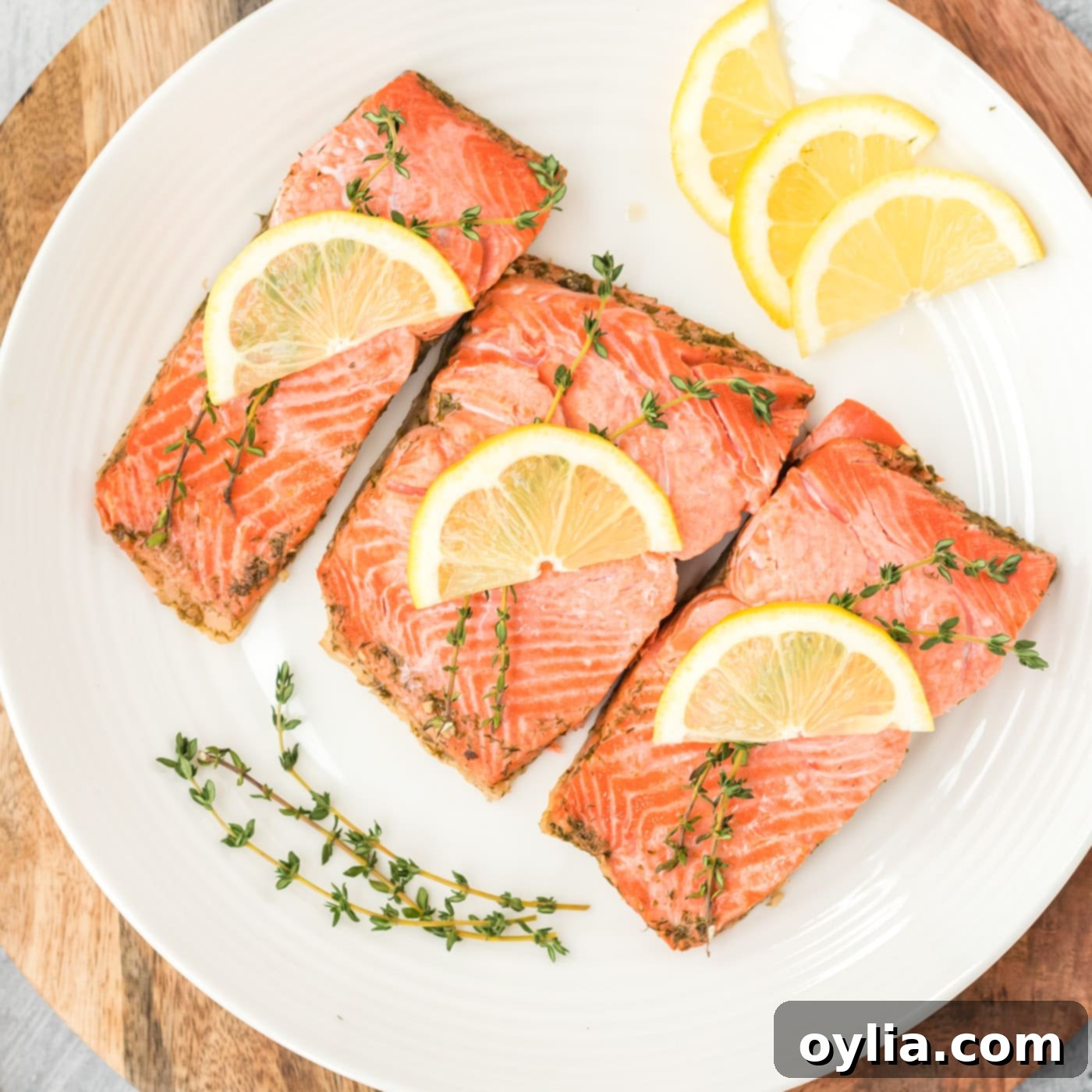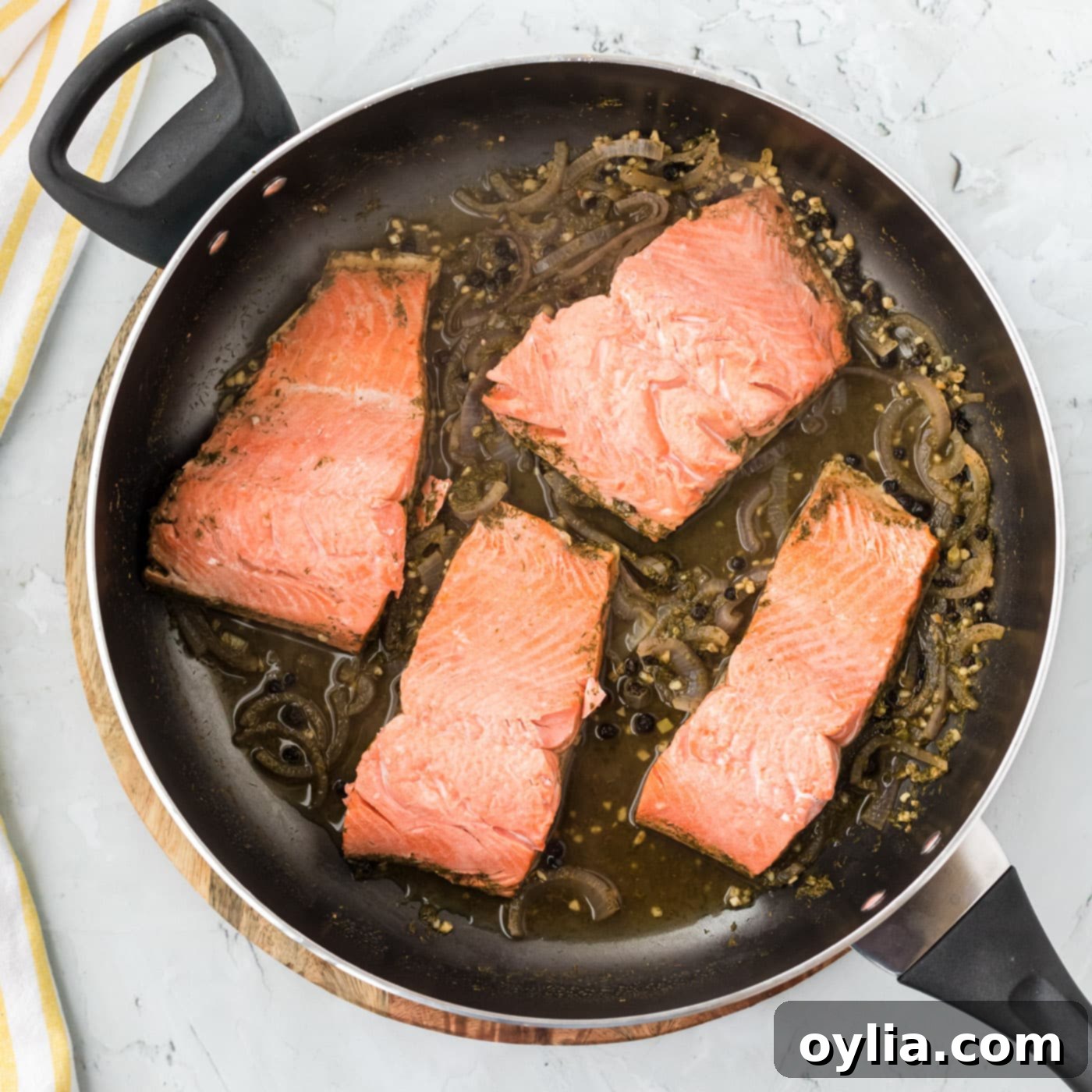Easy Poached Salmon: Tender, Flaky & Healthy in Just 8 Minutes
Craving a light, flavorful, and incredibly quick meal? Look no further than this fantastic easy poached salmon recipe! In just 8 minutes from start to finish, you can achieve perfectly tender, flaky salmon fillets that are bursting with natural flavor. Poaching is not only one of the simplest cooking methods, but it’s also among the healthiest, requiring no added butter or oil. Whether you’re a seasoned chef or a beginner in the kitchen, this method will quickly become a favorite for its effortless elegance and delightful results.
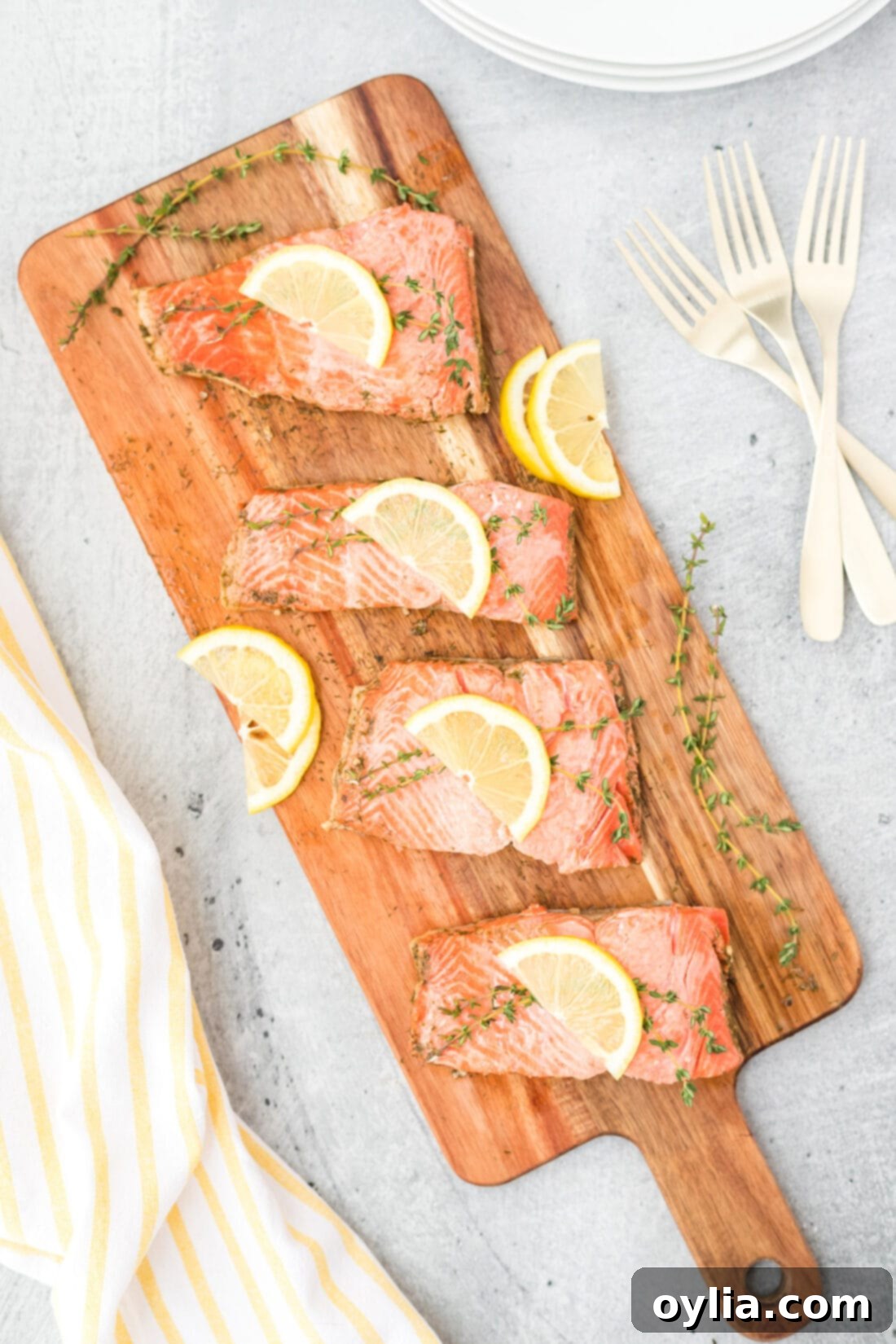
Why This Poached Salmon Recipe Is Your New Go-To
Our poached salmon recipe isn’t just easy; it’s a culinary revelation. Poaching involves gently simmering food in a flavorful liquid, which is particularly effective for delicate proteins like salmon. This gentle cooking method ensures the salmon retains its natural moisture, resulting in a supremely supple and flaky texture every single time. It’s almost impossible to overcook when poaching correctly, making it a foolproof technique for even novice cooks.
Beyond its incredible texture, poaching stands out as one of the healthiest ways to prepare salmon. By cooking in water infused with aromatics, you eliminate the need for butter or oil, significantly reducing the fat content of your meal. This makes it an excellent choice for those focusing on a heart-healthy diet or simply looking for lighter meal options.
The beauty of poached salmon lies in its versatility. It readily absorbs the flavors of the poaching liquid, allowing for endless customization with herbs, spices, and citrus. Once cooked, these tender fillets can be enjoyed hot or cold, making them perfect for meal prep. They are also ideal for transforming into other delicious dishes, such as vibrant salmon salads (a fantastic alternative to tuna salad) or savory fish cakes, adding a gourmet touch to your culinary repertoire.
Related Recipe: For a delicious pairing, consider our Rosemary Cream Sauce.
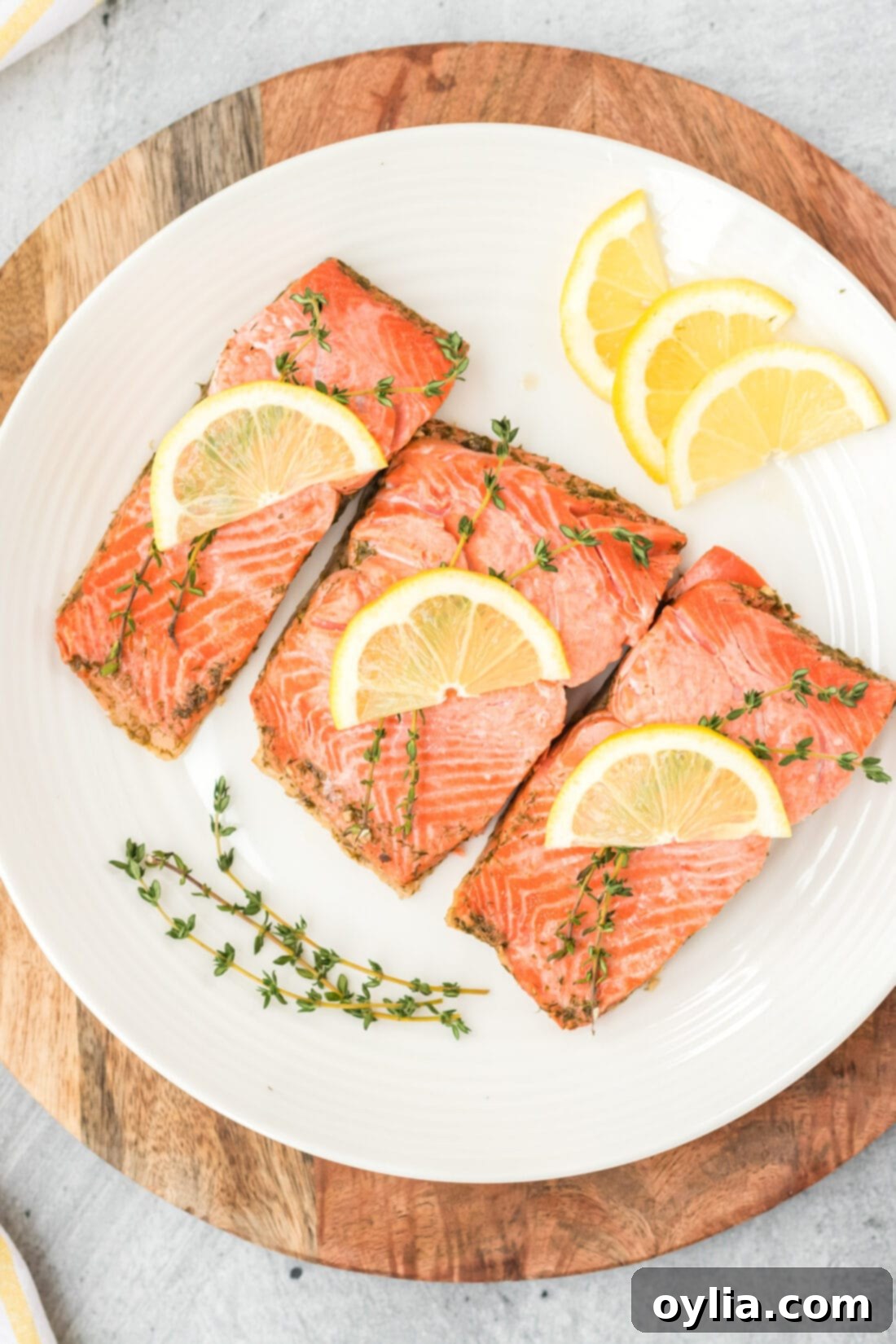
Essential Ingredients for Perfect Poached Salmon
Gathering your ingredients is the first step to creating this delightful meal. While the full, detailed list, exact measurements, and comprehensive instructions are available in the printable recipe card at the end of this post, here’s a glimpse of what you’ll need to prepare this easy poached salmon.
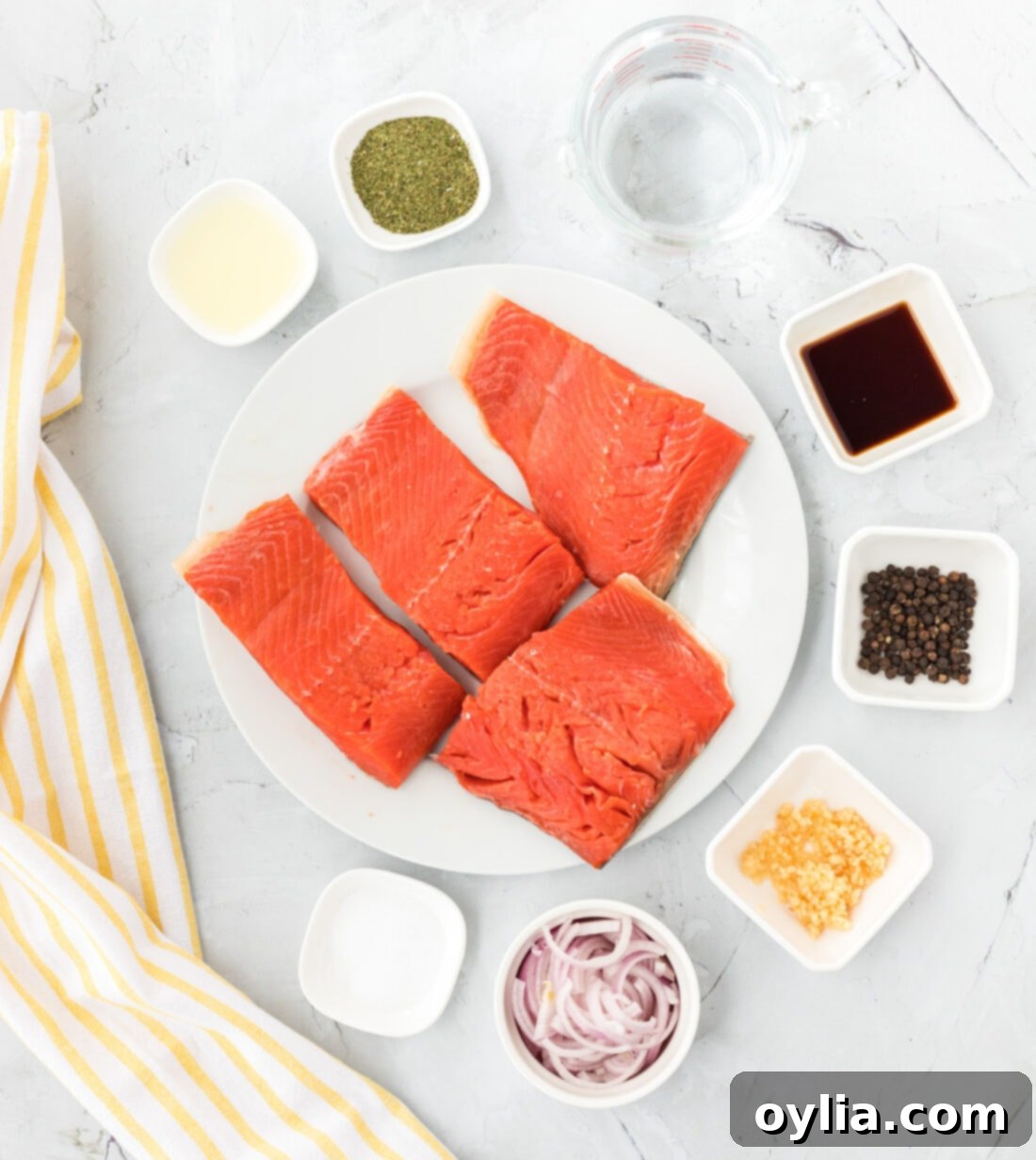
Ingredient Spotlight & Smart Substitution Suggestions
- SALMON: We specifically used Sockeye salmon for this recipe, which is known for its vibrant color, firm texture, and slightly thinner fillets compared to other varieties. If you opt for a different type of salmon, such as Atlantic or King salmon, which tend to be thicker, you will need to increase the cooking time to approximately 5 minutes to ensure it’s cooked through. Always aim for fresh, high-quality salmon fillets for the best flavor and texture. Look for bright, moist flesh and avoid any with a strong fishy odor.
- DRIED DILL: Dill is a classic pairing for salmon, offering a fresh, slightly tangy, and herbaceous note. You can use 1 Tablespoon of dried dill, or for an even fresher flavor, substitute with a generous sprig (or 2-3 tablespoons) of fresh dill.
- SHALLOT: A small sliced shallot adds a subtle, delicate onion flavor to the poaching liquid without overpowering the salmon. If you don’t have a shallot, a small slice of yellow onion or a few green onion whites can work in a pinch.
- WATER: This forms the base of your poaching liquid. While water is perfectly fine, you can elevate the flavor by substituting some or all of it with vegetable broth, white wine, or even a mix of water and clam juice for a richer seafood essence.
- LEMON JUICE: Fresh lemon juice is crucial for brightening the flavors and adding a hint of acidity that complements the richness of the salmon. Always use fresh lemon juice for the best results; bottled juice doesn’t offer the same vibrant taste.
- SALT: Essential for seasoning both the poaching liquid and the salmon itself. We recommend sea salt or kosher salt.
- BLACK PEPPERCORNS: Whole peppercorns add a gentle, aromatic spice to the liquid. If you only have ground black pepper, add about half a teaspoon directly to the liquid, but whole peppercorns provide a more nuanced flavor.
- MINCED GARLIC: Half a tablespoon of minced garlic infuses the poaching liquid with a savory depth. Freshly minced garlic is always preferred over pre-minced for superior flavor.
- LIQUID SMOKE: This is an optional but highly recommended ingredient. A tablespoon of liquid smoke adds a subtle, delicious smoky flavor to your poached salmon, reminiscent of a gently smoked fillet, without needing a smoker. Adjust to your preference.
How to Make Perfectly Poached Salmon: A Step-by-Step Guide
These step-by-step photos and instructions are here to help you visualize how to make this recipe. For the printable version, complete with precise measurements and comprehensive instructions, simply Jump to Recipe at the bottom of this post.
- Prepare the Poaching Liquid: Begin by placing all ingredients, with the exception of the salmon, into a large skillet. This includes your dried dill (or fresh sprig), sliced shallot, water, lemon juice, salt, black peppercorns, minced garlic, and liquid smoke. Bring this flavorful mixture to a gentle boil over medium-high heat. You’ll notice the aromas beginning to fill your kitchen as the flavors meld together.
- Add Salmon & Poach: Once the poaching liquid is boiling, carefully add the salmon fillets to the skillet. Ensure the fillets are mostly submerged in the liquid. Reduce the heat to medium, then cover the skillet with a lid. Allow the salmon to cook gently for just 2-3 minutes. This short cooking time is perfect for thinner Sockeye salmon, ensuring it remains incredibly tender without drying out. If using thicker salmon, extend this time to about 5 minutes. The key is gentle simmering, not a rolling boil.

- Serve Immediately: Once the cooking time is up, turn off the heat. Using a fish turner spatula, which is designed for delicate foods, carefully lift the poached salmon fillets out of the liquid and transfer them to a platter or individual plates. Serve immediately and enjoy the tender, flaky goodness!
Frequently Asked Questions & Expert Tips for Poached Salmon
Salmon is safely cooked when it reaches an internal temperature of 145°F (63°C). To ensure accuracy, insert an instant-read thermometer into the thickest part of the salmon fillet. Visually, the flesh will appear opaque and flake easily with a fork.
To maintain freshness and flavor, store any leftover poached salmon in an airtight container in the refrigerator. It will keep well for 2-3 days. Poached salmon is also delicious cold, making it perfect for lunch salads or quick snacks.
Yes, it’s generally recommended to leave the skin on the salmon when poaching. The skin acts as a protective barrier, helping the fillet hold its shape and preventing it from flaking apart during the gentle cooking process and when transferring it from the skillet. Once the salmon is cooked, the skin can be easily removed and discarded if desired.
Absolutely! If using frozen salmon, it’s best to thaw it completely in the refrigerator overnight before poaching. If you’re in a hurry, you can quick-thaw it under cold running water. Ensure it’s fully thawed to promote even cooking and prevent a rubbery texture.
A large, wide skillet or a shallow pot with a tight-fitting lid is ideal. The key is to choose one that allows your salmon fillets to lie in a single layer without overcrowding. This ensures they cook evenly. A non-stick surface can also be helpful for easy removal.
Expert Tips for the Best Poached Salmon:
- Don’t Overcrowd: Ensure your salmon fillets are in a single layer and not crammed in the skillet. If cooking a larger quantity, work in batches. Overcrowding can lower the liquid temperature and result in uneven cooking.
- Gentle Simmer: The poaching liquid should be at a gentle simmer, not a vigorous boil. Small bubbles should just break the surface. Too high a heat can toughen the salmon.
- Resting Time: While salmon cooks quickly, letting it rest for a minute or two after removing it from the poaching liquid allows the juices to redistribute, leading to an even more tender and flavorful result.
- Customize Your Aromatics: Don’t be afraid to experiment with your poaching liquid. Bay leaves, slices of cucumber, orange peel, or different herbs like thyme and parsley can add wonderful layers of flavor. See our “Flavorful Poaching Liquid Variations” section for more ideas!
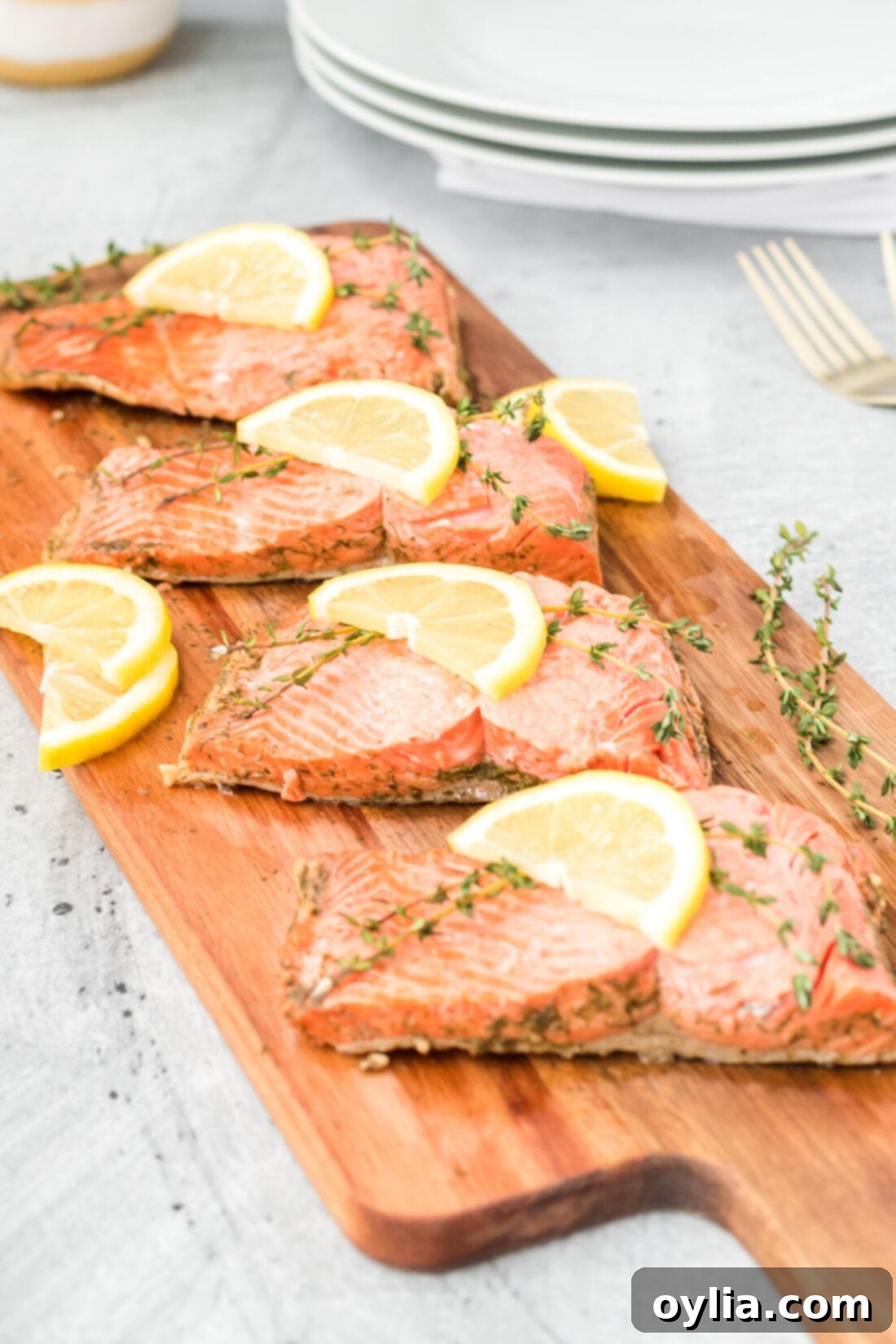
Delightful Serving Suggestions for Poached Salmon
Poached salmon is incredibly versatile and pairs beautifully with a wide array of side dishes. Its delicate flavor allows it to be the star of the plate or a complementary component in a larger meal. Here are some ideas to inspire your next dinner:
- Classic Vegetable Pairings: Serve alongside steamed or roasted vegetables such as tender potatoes, sweet carrots, crisp broccoli, vibrant roasted green beans, or elegant asparagus. A drizzle of the poaching liquid over the vegetables can add extra flavor.
- Hearty Grains: For a more substantial meal, serve your poached salmon with fluffy white rice, brown rice, quinoa, or couscous.
- Fresh Salads: Flake the cooled salmon over a bed of mixed greens, spinach, or kale for a light and healthy salad. Add cherry tomatoes, cucumber, red onion, and a light vinaigrette. It’s also excellent when mixed into a creamy dill or lemon-herb salmon salad, similar to a tuna salad but with a more refined texture.
- Creamy Sauces: While poached salmon is delicious on its own, it also accepts various sauces well. A simple dill sauce, a light lemon-butter sauce (if not strictly avoiding oil), or a homemade aioli can elevate the dish.
- Breakfast or Brunch: Enjoy cold poached salmon atop a toasted bagel with cream cheese and capers, or alongside scrambled eggs for a protein-rich start to your day.
Explore More Delicious Salmon Recipes
If you love salmon as much as we do, you’re in for a treat! We have a variety of salmon recipes to suit every taste and cooking method. From grilling to baking, there’s a salmon dish for every occasion:
- Grilled Salmon
- Salmon Tacos
- Baked Salmon
- Maple Soy Salmon
- Smoked Salmon Dip
- Cedar Plank Salmon
- Instant Pot Salmon
- Pan Seared Salmon
The Incredible Health Benefits of Enjoying Salmon
Salmon is not just delicious; it’s a nutritional powerhouse, making it a fantastic addition to any healthy diet. When you choose to poach salmon, you maximize these benefits by avoiding added fats from frying or baking with oils.
- Rich in Omega-3 Fatty Acids: Salmon is world-renowned for its high content of Omega-3 fatty acids (EPA and DHA). These essential fats are crucial for brain health, reducing inflammation, and supporting cardiovascular health by lowering blood pressure and reducing the risk of heart disease.
- Excellent Source of Protein: A single serving of salmon provides a substantial amount of high-quality protein, which is vital for muscle repair, growth, and overall bodily functions. Protein also helps keep you feeling full and satisfied, aiding in weight management.
- Packed with Vitamins: Salmon is a great source of several B vitamins, including B12, Niacin (B3), and B6, which play key roles in energy production and brain function. It also contains a good amount of Vitamin D, important for bone health and immune function, and Vitamin E, an antioxidant.
- Minerals Galore: This flavorful fish offers essential minerals like potassium, which helps regulate fluid balance and blood pressure, as well as selenium, an antioxidant that supports thyroid function and protects cells from damage.
- Low in Saturated Fat: Poaching ensures that salmon remains a lean protein source, naturally low in saturated fat, making it a healthier alternative to many red meats.
By incorporating poached salmon into your meals, you’re not just enjoying a quick and tasty dish; you’re actively nourishing your body with vital nutrients that contribute to overall well-being. It’s truly a win-win!
Flavorful Poaching Liquid Variations to Try
While our basic poaching liquid is wonderfully aromatic, the beauty of poaching lies in its adaptability. You can easily switch up the flavors to create an entirely new culinary experience. Here are some ideas for customizing your poaching liquid:
- Mediterranean Zest: Add slices of orange, a few sprigs of fresh oregano or thyme, and a dash of white wine to your water. Finish with a squeeze of fresh lemon after cooking.
- Asian Inspired: Substitute water with a mix of vegetable broth and a tablespoon of soy sauce. Add a slice of ginger, a dash of rice vinegar, and a few drops of sesame oil to the liquid. Garnish with chopped green onions and a sprinkle of sesame seeds.
- Herbal Infusion: For a deeper herbaceous flavor, try a medley of fresh herbs like parsley, tarragon, and chives. A few bay leaves can also add a lovely, subtle background note.
- Spicy Kick: If you enjoy a bit of heat, add a pinch of red pepper flakes or a few thin slices of fresh jalapeño to your poaching liquid. A squeeze of lime juice instead of lemon can further enhance this profile.
- Rich Broth Base: For a more robust flavor, use chicken or fish broth instead of water. This will add significant depth and a more savory profile to your salmon.
Experimenting with these variations can keep your poached salmon meals exciting and tailored to your specific taste preferences!
I love to bake and cook and share my kitchen experience with all of you! Remembering to come back each day can be tough, that’s why I offer a convenient newsletter every time a new recipe posts. Simply subscribe and start receiving your free daily recipes!
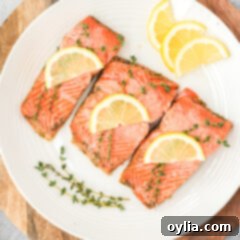
Poached Salmon
IMPORTANT – There are often Frequently Asked Questions within the blog post that you may find helpful. Simply scroll back up to read them!
Print It
Pin It
Rate It
Save ItSaved!
Ingredients
- 1 ½ pounds salmon fillets
- 1 Tablespoon dried dill or 1 large sprig of fresh dill
- 1 small shallot thinly sliced
- 1 cup water
- 1 Tablespoon fresh lemon juice
- 1 teaspoon salt
- 1 teaspoon black peppercorns
- ½ Tablespoon minced garlic
- 1 Tablespoon liquid smoke
Things You’ll Need
-
Large skillet with a tight-fitting lid
-
Fish turner spatula
-
Vinyl gloves for handling raw salmon (optional, but recommended for hygiene)
Before You Begin: Important Notes & Tips
- Salmon is perfectly cooked when its internal temperature reaches 145°F (63°C). Use an instant-read thermometer inserted into the thickest part of the fillet for accuracy.
- This recipe uses Sockeye salmon, which has thinner fillets and cooks quickly. If you’re using a thicker variety of salmon (like Atlantic or King), increase the cooking time to approximately 5 minutes.
- Store any leftover poached salmon in an airtight container in the refrigerator for up to 2-3 days. It’s delicious served cold the next day!
- Always use fresh lemon juice for the best vibrant flavor.
- Leaving the skin on the salmon during poaching helps the fillet stay intact and makes it easier to remove from the skillet. You can remove the skin after cooking if preferred.
Instructions
-
Combine all ingredients EXCEPT for the salmon into a large skillet with a tight-fitting lid. Bring this aromatic mixture to a gentle boil over medium-high heat.
-
Carefully add the salmon fillets to the boiling water mixture, ensuring they are mostly submerged. Reduce the heat to medium-low, cover the skillet, and cook for 2-3 minutes (for Sockeye salmon) or 5 minutes (for thicker salmon varieties). The liquid should maintain a gentle simmer.
-
Turn off the heat. Using a fish turner spatula, gently lift the perfectly poached salmon fillets out of the liquid and transfer them to your serving platter or individual plates. Serve immediately and enjoy!
Nutrition Information
The recipes on this blog are tested with a conventional gas oven and gas stovetop. It’s important to note that some ovens, especially as they age, can cook and bake inconsistently. Using an inexpensive oven thermometer can assure you that your oven is truly heating to the proper temperature. If you use a toaster oven or countertop oven, please keep in mind that they may not distribute heat the same as a conventional full sized oven and you may need to adjust your cooking/baking times. In the case of recipes made with a pressure cooker, air fryer, slow cooker, or other appliance, a link to the appliances we use is listed within each respective recipe. For baking recipes where measurements are given by weight, please note that results may not be the same if cups are used instead, and we can’t guarantee success with that method.
